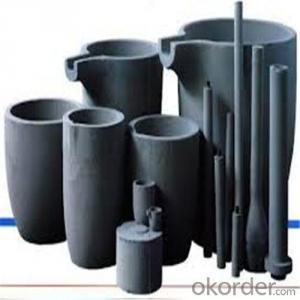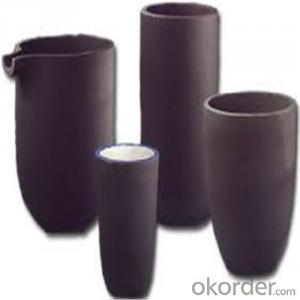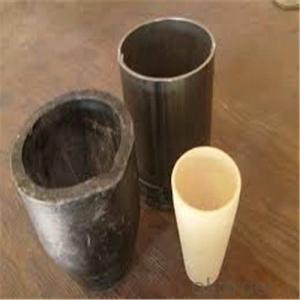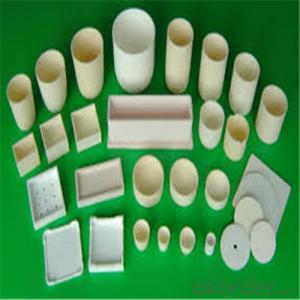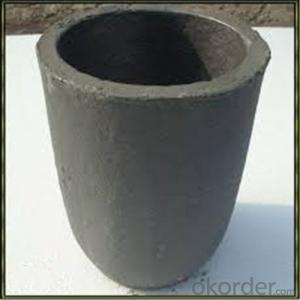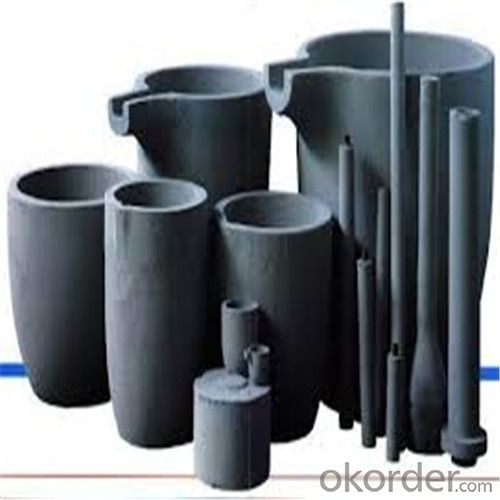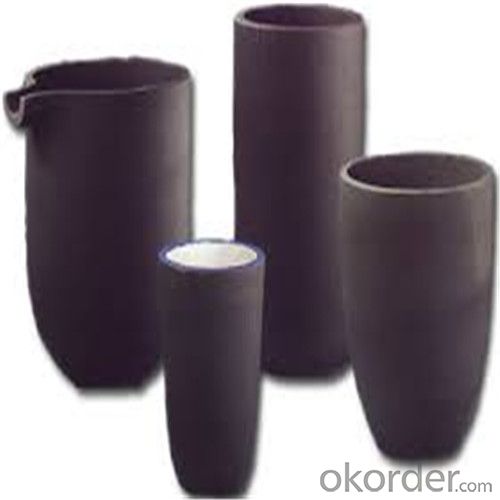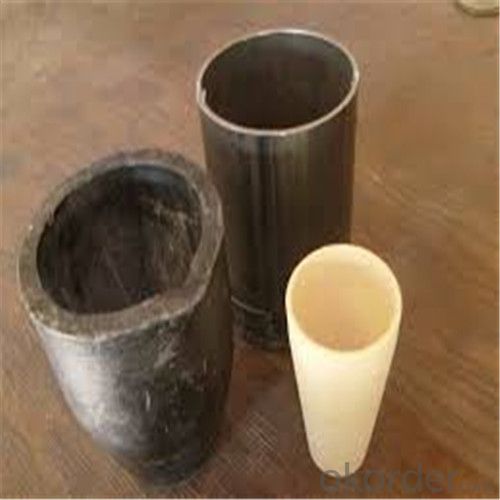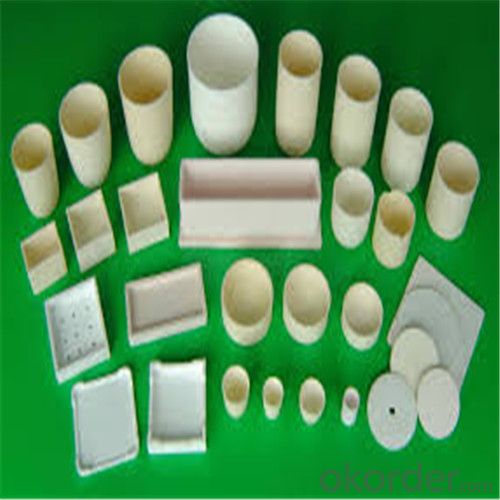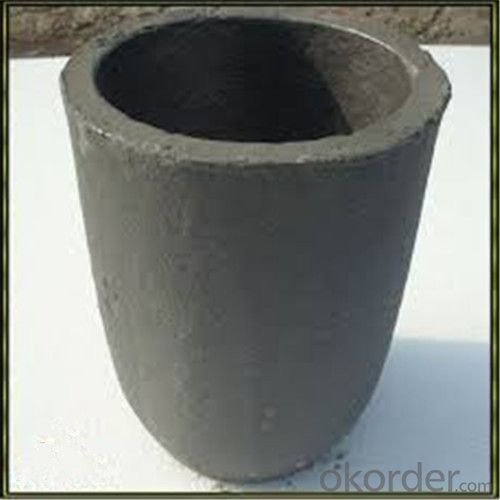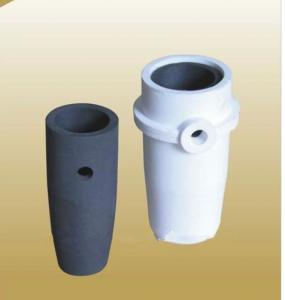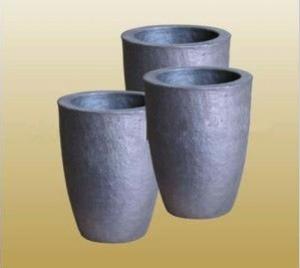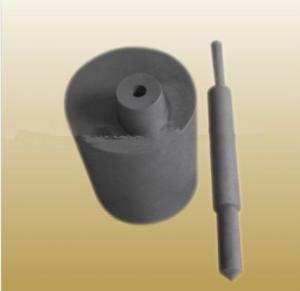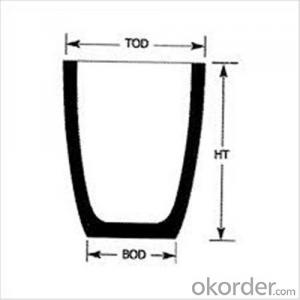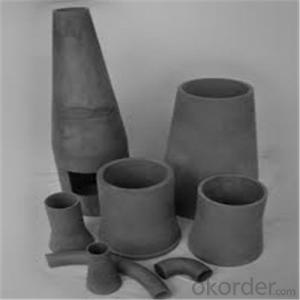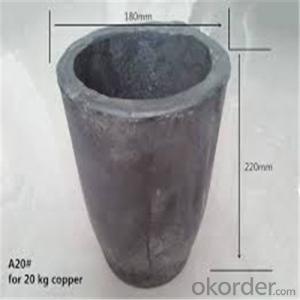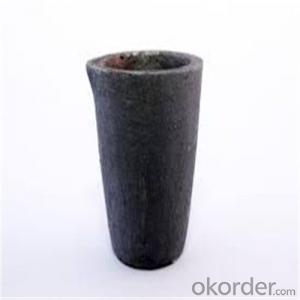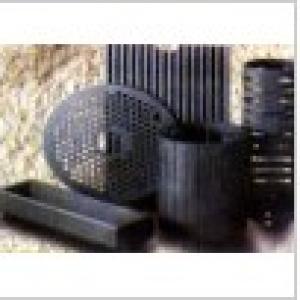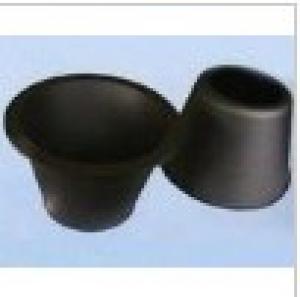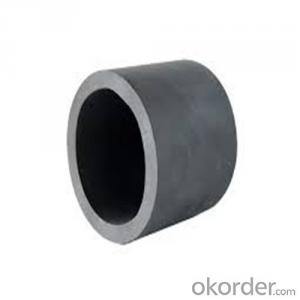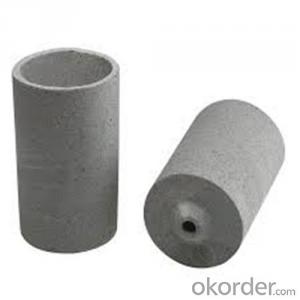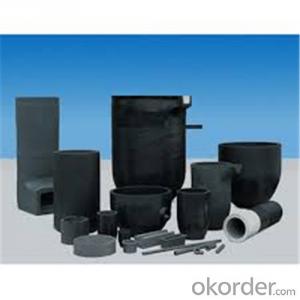SiC Graphite Crucibles For Melting Aluminium And Copper, Brass
- Loading Port:
- Shanghai
- Payment Terms:
- TT OR LC
- Min Order Qty:
- 1 pc
- Supply Capability:
- 1000 pc/month
OKorder Service Pledge
OKorder Financial Service
You Might Also Like
Quick Details for SiC Graphite Crucibles For Melting Aluminium And Copper, Brass
| Type: | High Strength, graphite crucible crucible | Application: | melting metal | Height: | as your requirements |
| Composition: | High Pure | Top Diameter: | 10-600mm | Bottom Diameter: | 10-1000mm |
| Place of Origin: | China (Mainland) | Brand Name: | Model Number: | ||
| Color: | Black grey | Si3N4%: | 5min | Fe2O3%: | 0.7max |
| C%: | 30-45 | Apparent porosity: | 30max | Refractoriness: | 1680 |
| Bulk Density: | 1.71min | Using life: | >5000 hours | MAX temperature: | 1600c |
Packaging & Delivery
| Packaging Details: | Seaworty packing or as per customer's detail requirement of graphite crucible. |
| Delivery Detail: | within 20-30 days after confirm order of graphite cru |
Super Quality Long Working Life SiC Graphite Crucibles For Melting Aluminium And Copper, Brass
Product Description
Specifications for Graphite Silicon Carbide Crucible For Aluminum Melting :
1.Long working lifetime: its working lifetime is increased 3-5 times over normal clay-crucible due to the compact body formed under high pressure.
2.High thermal conductivity: high-density body and low apparent porosity greatly improve its heat conductivity.
3.New-style materials: new heat conduction material ensures faster heat conductivity and pollution-free product, reduces adherent slag.
4.Resistance to corrosion:better anti-corrosion than normal clay-crucible.
5.Resistance to oxidation: advanced process dramatically improves its oxidation resistance, which ensures persistent heat conductivity and long working lifetime.
6.High-strength: high-density body and logical structure make the product better compression property.
7.Eco-friendly: energy-efficient and pollution-free, not only ensure metal product purity, but also ensure sustainable development on environment.
8.Multi-function: Can be used in induction graphite crucible furnace
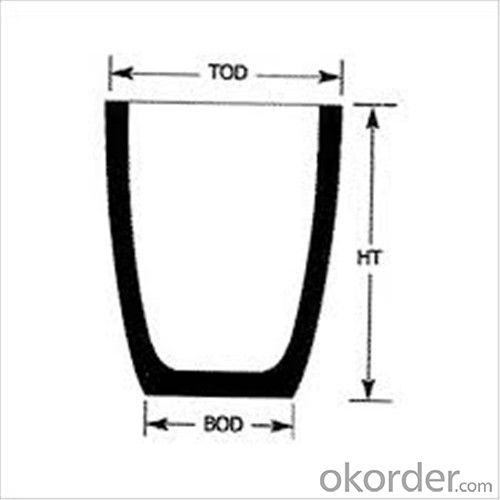
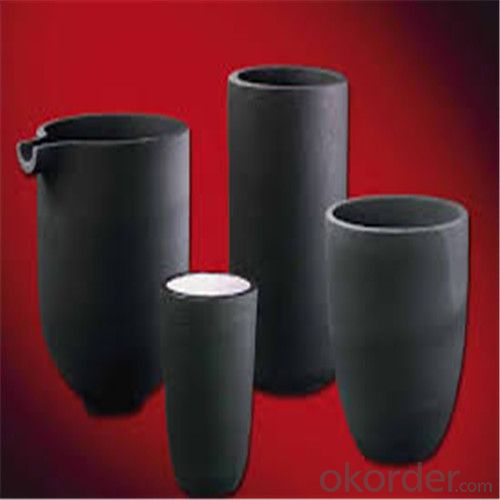
Physicochemical Properties of graphite crucible:
The crucible is an utensil or melting tank vessels that is made of refractory material (such as clay, graphite, quartz or difficult molten metal iron, etc.).
Graphite crucible, with is special advantages and Plasticity, is widely used in the smelting area, e.g. gold smelting, silver smelting, aluminum smelting, cooper smelting, etc.
high pure graphite | ||||
Item | Unit | baked twice | baked three time | baked four times |
impregnated once | impregnated twice | impregnated three times | ||
grain size | mm | ≤325μm | ≤325μm | ≤325μm |
Bulk density | g/cm3 | ≥1.68 | ≥1.78 | ≥1.85 |
Specific resistance | μΩ.m | ≤14 | ≤14 | ≤13 |
Bending strength | MPa | ≥25 | ≥40 | ≥45 |
Compressive strength | MPa | ≥50 | ≥60 | ≥65 |
Ash content | % | ≤0.15 | ≤0.1 | ≤0.05 |
Fine-grain Specialty Graphite FXG-1 | Fine-grain Specialty Graphite FXG-2 | ||||
Item | Unit | Guarantee value | Typical value | Guarantee value | Typical value |
Max grain size | mm | 0.8 | 0.8 | 0.8 | 0.8 |
Bulk density | g/cm3 | ≥1.70 | 1.73 | ≥1.73 | 1.76 |
Specific resistance | μΩ.m | ≤8.5 | 7.5 | ≤8.0 | 7 |
Bending strength | MPa | ≥10.0 | 11 | ≥12.0 | 12.5 |
Compressive strength | MPa | ≥24.0 | 27 | ≥31.0 | 34 |
Thermal Condcutivity | W/(m.k) | ≥120 | 150 | ≥130 | 160 |
C.T.E.(100-600) °C | 10-6/°C | ≤2.5 | 2.2 | ≤2.5 | 2.1 |
Ash content | % | ≤0.3 | 0.09 | ≤0.3 | 0.09 |
NO | Top diameter | Bottom diameter | Height | Tolerance | Capacity(Kg5%) |
2 | 90 | 50 | 55 | 2 | 0.3 |
3 | 105 | 80 | 93 | 2 | 0.5 |
4 | 102 | 80 | 100 | 2 | 0.6 |
5 | 112 | 82 | 130 | 2 | 0.8 |
6 | 120 | 82 | 141 | 2 | 0.9 |
8 | 138 | 90 | 153 | 2 | 1.2 |
12 | 148 | 100 | 181 | 2 | 1.8 |
16 | 156 | 110 | 190 | 2 | 2.3 |
20 | 180 | 120 | 230 | 2 | 3 |
25 | 186 | 128 | 248 | 2 | 3.7 |
Packaging & Shipping
Package: Wooden case and wooden pallet or pack as customer's requirement of graphite crucible.
Delivery time: depend on distance, usually 20 days to 50days after deposit of graphite crucible.
Our Services
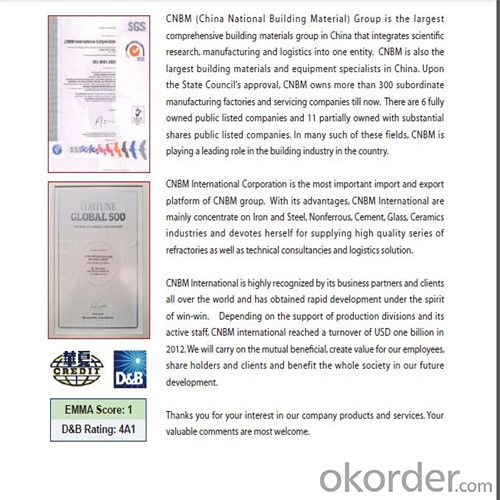

Why choose CMAX?
High puriy material make sure high max working temperature,
Tight tolerance make sure the right installation.
Large quantity in stock ensured fast delivery.
Large capacity reduce materical prices.
Our service :
Inquiry response: Your inquiries will be replied in 24 hours.
Sample support: Two free samples are available in 3~5days.
Delivery time: Your shipment will be loaded in 15~25days.depends on quantity.
Payment term: T/T, L/C, Western Union (Sample only)
We can supply the products according to customer's drawings, samples and performance requirement.
Other Products


FAQ
1.What's your MOQ?
We will indicate the MOQ for each item in the quotation list. We accept the sample and trail order.
2.Can I negotiate the Prices?
Sure, we may consider discounts for bulk order of products.
3.How long will it take to complete my order?
For the stock items, we can arrange the shippment within 2~3days after received your payment. For the customized items, we will indicate the delivery time in the quotation list.
4.Can you give warranty of your products?
Yes, we extend a 100% satifisfaction guarantee on all items. Please feel free to provide timely feedback if you're not satisfied with N&D's Quality and Service. For the overseas orders, if there is a quality problem, please kindly to provide the picturers to show the problem by e-mail. We will provide the replacements to you at our cost according to actual conditions.
5.Can I visit you?
Sure. If you're a volume buyer and would like to visit our in-house products and production line, please contact us to make an appointment.
- Q: How do you determine the appropriate crucible lid seal for a specific application?
- To determine the suitable crucible lid seal for a specific application, several factors must be taken into account. The first step is to evaluate the type of material used in the crucible, as different materials may require different seal types. For instance, if the application involves high temperatures or corrosive materials, a seal that can withstand these conditions is necessary. Next, the operating temperature of the application should be considered. It is important to select a lid seal that can endure the temperature range without deteriorating or compromising the seal's integrity. In high-temperature applications, specialized seals made from materials like graphite or ceramic might be required. Pressure conditions inside the crucible are another crucial factor. If the application involves high-pressure environments, a lid seal that can handle the pressure without leaking or failing is essential. It is vital to choose a seal that can maintain a tight seal specifically under the pressure conditions of the application. Additionally, the size and shape of the crucible and lid should be taken into account. The seal must fit snugly and securely to ensure a proper seal. Accurate measurements of the dimensions are necessary, and a seal that matches the shape and size of the crucible and lid should be selected. Moreover, the frequency of lid removal should also be considered. If the crucible needs to be frequently opened and closed, a seal that is easy to install and remove without compromising effectiveness is required. Quick-release or reusable seals may be suitable for such applications. Lastly, seeking guidance from experts or manufacturers specializing in crucible lid seals is recommended. They can offer valuable advice based on their knowledge and experience. They can recommend specific seals based on the application requirements and provide information on the performance and compatibility of various seal options. In conclusion, determining the appropriate crucible lid seal for a specific application involves considering factors such as the material, operating temperature, pressure conditions, size, shape, lid removal frequency, and seeking expert advice. By carefully assessing these factors, a lid seal can be selected to ensure a secure and reliable sealing solution for the crucible application.
- Q: Can graphite crucibles be used for melting explosives?
- No, graphite crucibles should not be used for melting explosives as graphite is a highly flammable material and can potentially react with explosive substances, leading to dangerous situations. It is recommended to use specialized containers and equipment designed for handling explosives to ensure safety.
- Q: Can graphite crucibles be used for thermal analysis?
- Thermal analysis does not usually involve the use of graphite crucibles. Graphite crucibles are primarily utilized for high temperature purposes, such as the melting and casting of metals, as well as chemical reactions that necessitate intense heat. When conducting thermal analysis, diverse techniques are employed to examine the physical and chemical properties of materials during temperature changes. Some of these techniques comprise differential scanning calorimetry (DSC), thermogravimetric analysis (TGA), and measurements of thermal conductivity, among others. To carry out these types of analyses, specific equipment and materials are required. Generally, ceramic or metal crucibles are utilized due to their superior thermal conductivity and stability at high temperatures, which ensures precise and dependable measurements. These crucibles are engineered to endure thermal cycling and provide a controlled environment for the analyzed sample.
- Q: Can graphite crucibles be used for melting thermoplastics?
- No, graphite crucibles cannot be used for melting thermoplastics. Graphite crucibles are typically used for high-temperature applications such as melting metals and alloys due to their high melting point and excellent thermal conductivity. Thermoplastics have much lower melting points and require crucibles made of materials such as stainless steel or ceramic to withstand the lower temperatures and prevent contamination.
- Q: What are the different methods of preheating a graphite crucible?
- Preheating a graphite crucible can be done using various methods, depending on specific requirements and available equipment. Here are some commonly used techniques: 1. Induction Heating: An electromagnetic field is generated by an induction coil, rapidly heating the graphite crucible. Known for its efficiency and quick heating capabilities, induction heating is widely employed. 2. Resistance Heating: By passing an electric current through the graphite crucible, heat is generated due to the resistance encountered by the crucible material. Specialized resistance heating elements or wires are needed for this method. 3. Gas Flame Heating: Placing the graphite crucible over a gas burner or torch gradually raises its temperature using the heat from the flame. This method is commonly employed in smaller-scale applications or situations where electricity is not readily accessible. 4. Electric Furnace Heating: Electric furnaces are specifically designed for heating crucibles. The crucible is placed inside the furnace, which generates heat through resistance heating elements. This method offers controlled and uniform heating, making it suitable for precise temperature requirements. 5. Microwave Heating: In specific cases, microwaves can be utilized to preheat graphite crucibles. This method utilizes microwave radiation to generate heat within the crucible. However, it requires specialized equipment capable of withstanding high temperatures and is not as commonly used as other methods. It should be noted that the choice of preheating method depends on factors such as crucible size, desired heating rate, and availability of specific equipment. Proper preheating ensures that the graphite crucible reaches the required temperature before being used for applications such as metal melting, chemical reactions, or thermal analysis.
- Q: What are the differences in production techniques for different graphite crucible models?
- . Pliers can be divided into three categories: metal tongs, clay crucibles and graphite crucibles. Lynn disaster can be divided into: graphite crucible, crucible smelting and refining non-ferrous metal alloy steel can curse three. According to the shape is divided into universal and special-shaped two.
- Q: Graphite producer / graphite manufacturer / graphite enterprise brand, where is there?
- Huixian jade deep graphite mold factory is located in Foshan, Guangdong Province Nanhai Luo Village Industrial Zone, convenient transportation, covers an area of 2500 square meters. With advanced mechanical equipment and many years of experience in the development of engineers, the Pearl River Delta region is a large graphite mold processing enterprises, the main products are:1 kinds of high purity graphite mold, metal continuous casting graphite mould, sealing ring for chemical mechanical, geological drill bit sintering mold, graphite heating element, aluminum stopper and a stirring rod and a bowl bottom base, pouring pipe, launder jacket, graphite ring, roller, lath, Shi Mogan, Guo, graphite electrode, graphite plate graphite precision device.2, diamond products, mold, saw blade mold, drill bit mold, roller mold, grinding wheel, crucible and all kinds of special-shaped mold.3, distribution of various high-quality high purity graphite materials and special graphite G4 material, EDM, continuous casting materials, square material, round material, graphite powder.
- Q: Can graphite crucibles be used for catalyst preparation?
- Catalyst preparation can indeed make use of graphite crucibles. Given their exceptional thermal conductivity and resistance to thermal shock, graphite crucibles are frequently employed in high temperature scenarios. They are able to endure temperatures of up to 3000°C, rendering them well-suited for multiple catalyst preparation methods that necessitate high temperatures. Graphite crucibles furnish a steady and unreactive setting for catalyst synthesis and preparation. They do not readily interact with most chemicals, enabling compatibility with a wide array of catalyst materials and precursors. This facilitates effective catalyst synthesis without the risk of impurities or undesired reactions. Moreover, graphite crucibles are renowned for their durability and lengthy lifespan, making them a cost-effective choice for repetitive use in catalyst preparation. They can be effortlessly cleaned and reused, thereby reducing the overall expenditure of the catalyst preparation process. It is important to note that the selection of crucible material may be contingent upon the specific catalyst preparation process and the chemicals involved. While graphite crucibles generally prove suitable for numerous catalyst preparation applications, some highly reactive or corrosive chemicals may necessitate the use of alternative crucible materials, such as ceramic or quartz crucibles. Consequently, it is crucial to consider the specific requirements of the catalyst preparation process before opting for a particular crucible material.
- Q: Can graphite crucibles be used for melting food-grade materials?
- No, graphite crucibles should not be used for melting food-grade materials. Graphite is a form of carbon that can release impurities or contaminants when exposed to high temperatures. These impurities can be harmful if ingested or come into contact with food. It is recommended to use food-grade materials such as stainless steel or ceramic for melting food-grade materials to ensure the safety and quality of the end product.
- Q: Can graphite crucibles be used for metal powder sintering?
- Yes, graphite crucibles can be used for metal powder sintering. Graphite is a commonly used material for crucibles due to its high melting point, chemical inertness, and thermal conductivity. Metal powder sintering involves heating the powder to a high temperature to bond the particles together, and graphite crucibles are able to withstand these high temperatures without reacting with the metal powders. Additionally, graphite crucibles have good thermal conductivity, which helps to evenly distribute heat and ensure uniform sintering of the metal powder. Therefore, graphite crucibles are a suitable choice for metal powder sintering processes.
Send your message to us
SiC Graphite Crucibles For Melting Aluminium And Copper, Brass
- Loading Port:
- Shanghai
- Payment Terms:
- TT OR LC
- Min Order Qty:
- 1 pc
- Supply Capability:
- 1000 pc/month
OKorder Service Pledge
OKorder Financial Service
Similar products
Hot products
Hot Searches
Related keywords
